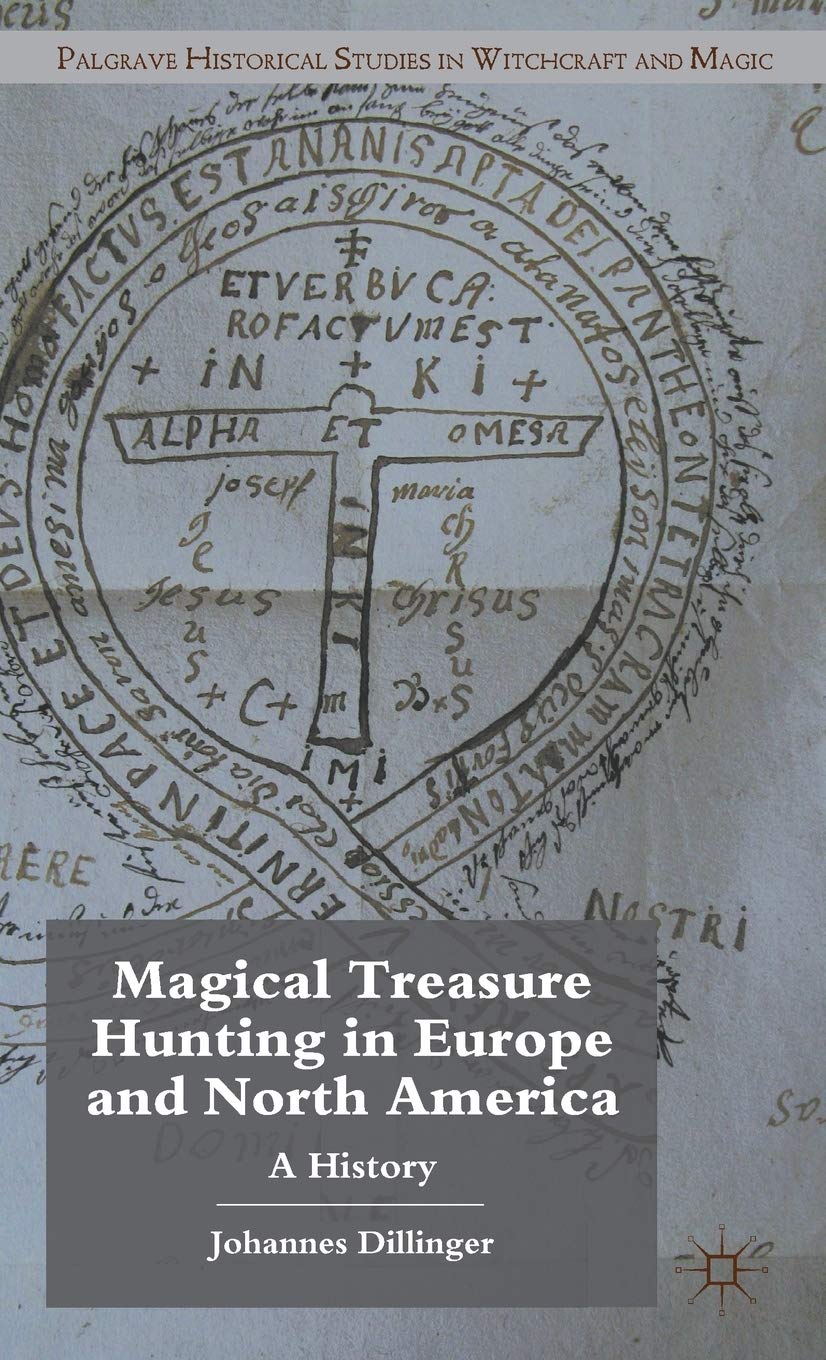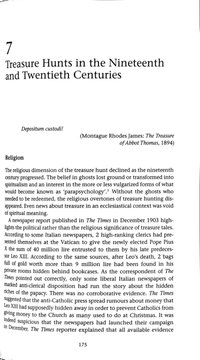Johannes Dillinger discusses Joseph's treasure hunting in light of European and North American traditions concerning lost treasures and guardian spirit/angels.
- Type
- Book
- Source
- Johannes Dillinger Non-LDS
- Hearsay
- Secondary
- Reference
Johannes Dillinger, Magical Treasure Hunting in Europe and North America: A History (Palgrave Historical Studies in Witchcraft and Magic; Basingstoke, UK: Palgrave Macmillan, 2012), 176-79
- Scribe/Publisher
- Palgrave MacMillan
- People
- Johannes Dillinger
- Audience
- Reading Public
- Transcription
There was, however, one notable exception from the general trend to a more secular, non-magical and non-religious understanding of treasure. Significantly, it was not a European but an American phenomenon. It used and adapted the old motifs in order to create a new religious narrative, and indeed a new Christian church: Mormonism. In 1838, Joseph Smith, the founder of the new denomination, described how he had found the Book of Mormon in some detail. An angel named Moroni came to Smith three times in the same night. He always had the same message: he told Smith where he could find ‘a book . . . written upon gold plates giving an account of the former inhabitants of this contingent (North America) and the source form whence they sprang’. Together with the book, Smith would find two stones in silver bows. Together with the book, Smith would find two stones in silver bows. The stones were the Urim and Thummim. ‘The use of these stones was what constituted Seers in ancient . . . times.’ They would enable Smith to translate the golden book. It is significant that according to Smith’s own account, the angel had to explicitly forbid him to use the golden book ‘for the purpose of getting rich’. Smith found the book hidden under a heap of stones in a stone box near the village in New York where he lived. According to his account, his happened in 1823. Following the advice of the angel, Smith supposedly did not take the book out of its secret deposit for another four years. Only then did he take it into his house and began to translate it. Attempts to steal the precious book from him failed. Smith said that he returned the gold plates that he had translated directly to Moroni, who took them away with him. Smith claimed that a New York expert in old languages, a Professor Anthon, to whom some of the characters on the plates had been shown, confirmed that they were indeed Egyptian, Chaldaic, Assyrian and Arabic and that his translation was correct.
There is no denying the fact that this is a treasure narrative. The topic of the story is obviously a supernatural find of an old object of very high material value that was hidden in the ground and that nobody could claim ownership of. Even in a narrative written several years after the event, Smith admitted quite openly that the golden book was attractive simply because of its value: the angel had to keep him from selling it. It is an interesting aside, Smith acknowledged the fact that may contemporaries saw him merely as a treasure hunter. He explained that between the discovery of the book and his work on the translation, Joseph Smith had worked for a prospector digging for silver in Pennsylvania: ‘Hence arose the very prevalent story of my having been a money digger.’ To rid himself of the odium of treasure hunting, Smith even claimed that he convinced his employer to give up prospecting. That an angel revealed the whereabouts of the hidden valuable object seems to have been a rather original element in Smith’s narrative: the angel replaced the ghost. However, saints and angels as treasure guardians were not unheard of, as we saw in Chapters 2 and 3. Smith later corrected himself, bringing his story even closer to the traditional treasure narrative. He explained that Moroni was a heavenly being but not an angel: he was the soul of a long-dead prophet’s son. Thus, the story was largely in keeping with traditional treasure tales.
His contemporaries were very critical about Smith’s autobiographical statements. His adversaries claimed that he had long been known as a treasure hunter and published detailed accounts of his early life to prove just that. As a schoolboy, Joseph Smith had been known as ‘Peepstone Joe’. He had claimed to be an expert in ‘foretelling futurity’ and finding lost or hidden objects, especially treasure. Peepstone Joe had carried two stones he called ‘peep stones’ in his hat. When he put the hat with the stones in it over his face, he could allegedly see things that were hidden and unknown. Young Smith was not simply a schoolboy horsing around—he seems to have expected payment for his magical services. It is of no importance whether this qualifies as fraud or as a rather absurd prank. In any case, Smith certainly enjoyed presenting himself as a treasure magician from an early age.
According to early Mormon authors, Smith still used the ‘Peepstone Technique’ when translating the book of Mormon:
Joseph Smith would put the seer stone into a hat, and put his face in the hat, drawing it closely around his face to exclude the light; and in the darkness the spiritual light would shine. A piece of something resembling parchment would appear, and on that appeared the writing. One character at a time would appear, and under it was the interpretation in English. Brother Joseph (Smith) would read off the English to Oliver Cowdery, who was his principal scribe, and when it was written down and repeated to Brother Joseph to see if it was correct, then it would disappear, and another character with the interpretation would appear.
Today, many Mormons admit freely that Smith had a rather dubious early life as a treasure hunter or fraud. They point out that according to Christian tradition, God often chooses very weak people as his messengers to that the power of the message itself becomes clearer.
Smith resacralized the treasure. His treasure story was evidently religious in character. He brought the treasure motif back to its roots in the medieval stories about saints and their relics. However, the sacred object in his narrative was no longer about memoria, the sacred memory of a saint. In a strangely ‘enlightened’ fashion, the treasure was now about a doctrine. In a way, the treasure—the golden Book of Mormon—was the doctrine.
When the first missionaries arrived in Continental Europe in the middle of the nineteenth century, they encountered a number of difficulties. Not least among these was the obvious parallel between Smith’s story and traditional treasure tales, which at that time were even better known than they are today. Orson Hyde, one of the first Mormons to preach in Germany, published his account of the discovery of the Book of Mormon in 1842. Heh told a story that significantly differed from Smith’s account. According to Hyde, Smith had indeed found old documents but these had only looked like gold. Hyde did not even mention any material value they might have had. A little like the treasures of folk belief had been able to turn into worthless materials, the golden plates had turned into yellowing parchment. In Hyde’s account, Smith resembled an antiquarian or an archaeologist rather than a treasure hunter. Evidently, the missionary did his best to obscure the obvious similarities between the story of the Book of Mormon and treasure tales. However, Hyde also integrated a new element that he had found in European treasure legends into the Mormon narrative. He wrote that when Smith unearthed the book, a horde of demons of horrible aspect passed him by. The idea that the devil tries to frighten treasure hunters with awful visions to that they run away or make some crucial mistake in the last moments of the dig was, of course, well-known in traditional treasure lore. Smith never wrote anything like that. Hyde apparently found the folkloristic motif useful: the demons had not frightened Smith away and they had evidently no power to hurt him. Within the logic of the old treasure tale, this proved that Smith really was a man of God and Moroni, his guardian, was neither a ghost nor a demon but really God’s messenger.
- Citations in Mormonr Qnas
The B. H. Roberts Foundation is not owned by, operated by, or affiliated with the Church of Jesus Christ of Latter-day Saints.


